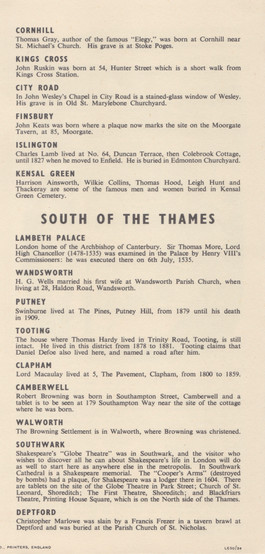Dunlop's Map of Literary London, 1950
- Peter Berthoud
- Oct 10, 2023
- 2 min read
Updated: Oct 12, 2023
Dunlop issued their attractive "Map of Central London and its Literary Associations" as a magazine advertisment and as a leaflet. The leaflet expands on the map's theme with additional notes.

Below the map is divided into four, slightly overlapping, sections and beneath that are all eight panels of accompanying text from the leaflet. Click on any map section or any text panel for an expanded view.
As with any project of this type, the map's literary inclusions and omissions are debatable. The map does not feature any writers who were alive in 1950. Given this restriction, an H.G. Wells fan might be delighted to find that despite his very recent death, in 1946, he features three times but a devotee of Virginia Woolf, who died in 1941, might be appalled that she doesn't appear at all. A reader today might question why Harrison Ainsworth is mentioned twice whilst Mary Shelley is passed over.
Similarly the map's non-literary landmarks include the, soon to be opened, Dome of Discovery at the Festival of Britain's South Bank site, London Zoo and the first phase of Battersea Power Station but not Buckingham Palace, Trafalgar Square or Downing Street, although the latter is highlighted in the text panels.
What Dunlop and the map's artist Xenia sought to produce was not an exhaustive literary guide nor a comprehensive map of the capital's sights but an attractive celebration of London's literary heritage that aimed to stimulate and encourage further exploration and by that measure they succeeded.
The map of literary London was one of 6 pictorial maps, by various artists, issued by Dunlop in 1950. The other maps in the series were: The West Country, The Lake District, Central Scotland, Shakespeare Country, North Country. All were printed by J. Howitt & Son Ltd for Dunlop Rubber Co. Ltd., Fort Dunlop, Birmingham




























